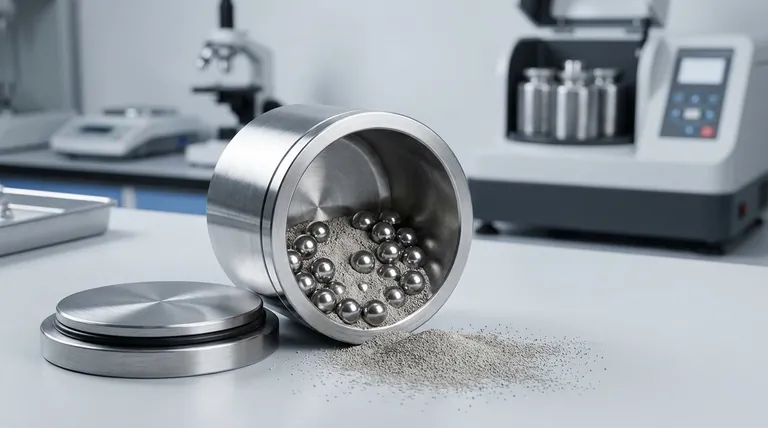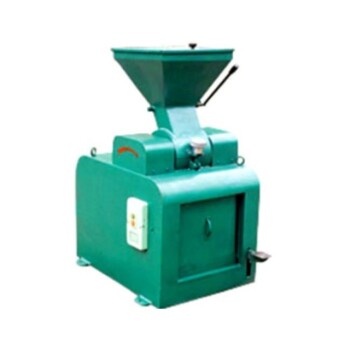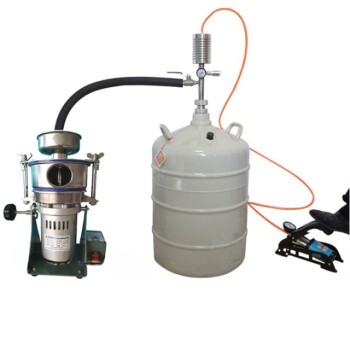To achieve accurate and repeatable X-Ray Fluorescence (XRF) results, the ideal particle size of a powdered sample should be extremely fine, typically below 50 microns (µm). This fine grinding is not arbitrary; it is the most critical step in creating a sample that is both homogeneous and presents a perfectly flat, stable surface to the instrument's X-ray beam.
The core objective of sample preparation for XRF is to eliminate physical variations between samples so that the only remaining variable is chemical composition. Fine particle size is the foundation for achieving this, as it directly impacts sample homogeneity and surface quality, the two biggest sources of analytical error.

The Principle: Why Particle Size Governs XRF Accuracy
A high-quality XRF measurement depends on the assumption that the small area being analyzed is perfectly representative of the entire bulk sample. Large, inconsistent particles violate this assumption in several critical ways.
Eliminating the "Particle Size Effect"
The X-ray beam penetrates only a shallow depth into the sample. If your sample consists of large particles of different minerals, the beam might disproportionately interact with just one or two particle types.
This "particle size effect" leads to an analysis of a few individual grains rather than a true average of the bulk material, creating significant errors. Grinding the sample down to a fine powder ensures thousands of tiny particles are exposed to the beam, providing a statistically representative chemical average.
Ensuring a Flawless, Flat Surface
XRF instruments are precisely calibrated based on a fixed distance between the X-ray source, the sample surface, and the detector. Any deviation from this distance will alter the measured intensity of the elemental signals.
Coarse or irregularly shaped particles create a rough, uneven surface when pressed into a pellet. This means different areas of the sample are at slightly different distances from the source and detector, introducing unpredictable errors and making your results unreliable.
Minimizing Voids and Increasing Density
Fine, uniform particles pack together much more densely and evenly when pressed. This process minimizes voids (empty spaces) within the sample pellet.
A dense, tightly packed sample is more stable, less likely to crumble, and provides a more consistent medium for the X-ray beam to travel through, further improving the precision of the measurement.
Understanding the Trade-offs of Sample Preparation
While fine grinding is essential for accuracy, it's a process that involves its own set of considerations. Being aware of these trade-offs is key to developing a robust analytical method.
The Risk of Contamination
The act of grinding can introduce contaminants into your sample. The material of the grinding vessel (e.g., tungsten carbide, agate, or zirconia) can wear down slightly, adding trace elements to your sample.
It is crucial to be aware of the composition of your grinding equipment and account for any potential contamination, especially when analyzing for those specific elements at low concentrations.
The Investment of Time and Effort
Achieving a particle size below 50 µm requires specialized equipment like a high-energy puck-and-ring mill and can be time-consuming.
For less demanding applications, such as simple material screening, a less rigorous grinding process may be acceptable. However, for high-precision, quantitative analysis, this step is non-negotiable. The required precision of your final result dictates the amount of effort you must invest in sample preparation.
Making the Right Choice for Your Goal
The necessary level of preparation is dictated entirely by the purpose of your analysis. Use your objective to guide your approach.
- If your primary focus is high-accuracy quantitative analysis: You must grind the sample to a fine powder (<50 µm) and press it into a dense, perfect pellet to eliminate physical effects.
- If your primary focus is routine process control: A consistent (but perhaps less fine) particle size may be sufficient, as long as the preparation method is identical for every sample to ensure comparability.
- If your primary focus is simple screening or identifying major elements: Analyzing loose powders or even solid pieces can work, but you must accept that the results are semi-quantitative at best due to significant surface and homogeneity errors.
Ultimately, mastering XRF analysis begins with mastering the consistent preparation of your samples.
Summary Table:
| Preparation Goal | Recommended Particle Size | Key Consideration |
|---|---|---|
| High-Accuracy Quantitative Analysis | < 50 µm | Essential for eliminating particle size effect and ensuring a flat, homogeneous surface. |
| Routine Process Control | Consistent, but may be less fine | Consistency in preparation method is paramount for sample comparability. |
| Simple Screening / Major Elements | Loose powder or solid pieces | Accept semi-quantitative results due to inherent surface and homogeneity errors. |
Achieve Laboratory Excellence with KINTEK
Unlock the full potential of your XRF analysis with sample preparation solutions from KINTEK. We specialize in providing the high-quality lab equipment and consumables you need to grind samples to the precise particle size required for accurate, repeatable results.
Let us help you eliminate analytical error and ensure data integrity. Our experts can guide you to the right mills, presses, and pellets for your specific application—from high-accuracy quantitative work to routine process control.
Contact us today to discuss your lab's needs and discover how KINTEK can be your partner in precision.
Visual Guide

Related Products
- Laboratory Ball Mill Jar Mill with Metal Alloy Grinding Jar and Balls
- Laboratory Grinding Mill Mortar Grinder for Sample Preparation
- Laboratory Sealed Hammer Crusher for Efficient Sample Preparation
- Laboratory Single Horizontal Jar Mill
- Stainless Steel Laboratory Ball Mill for Dry Powder and Liquid with Ceramic Polyurethane Lining
People Also Ask
- What is the preventive maintenance of ball mill? Ensure Maximum Uptime and Reliability
- What is the average speed of a ball mill? Optimize Grinding with Critical Speed Calculations
- What is the product size of a ball mill? Achieve Micron-Level Precision for Your Materials
- What is the purpose of ball milling? A Versatile Tool for Material Synthesis and Modification
- What are the factors affecting grinding efficiency? Optimize Your Process for Maximum Output



















